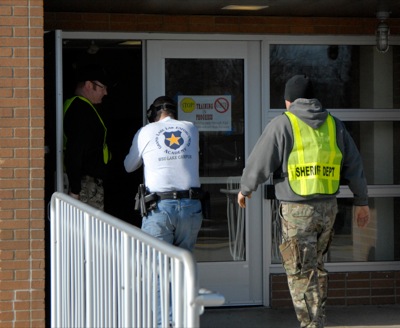Tuesday, December 30th, 2014
City leaders OK option on possible well field site
By William Kincaid
CELINA - Council members Monday night unanimously passed legislation authorizing a commercial lease with an option to purchase more than 16 acres of land east of the city for potential water wells to replace Grand Lake as a main drinking water source.
The ordinance was passed as an emergency measure after council members suspended the rules, doing away with the need for three public readings.
Test drilling for water at the site - north of Cisco Funeral Home along state Route 703 and south of the RJ Corman Railroad tracks - should start in January, officials said.
If an adequate supply of water is located underneath the 16.43-acre property, the farmland and wooded area could be purchased by the city for $750,000 from owners John J. Bertke and James F. Lampert.
The purchase would require the passage of additional legislation, city law director George Moore pointed out.
The city will initially pay $20,000 in rent to Bertke and Lampert to lease the land for a year, effective Jan. 1. The money will be appropriated from the water fund.
The city is permitted to drill, construct and/or complete water wells on the property and install pumping equipment. It also is granted ingress/egress rights.
If an adequate and sustainable water source is found, mayor Jeff Hazel believes the city could develop three well fields on the property, enough for reserve pumping. The city would continue using the existing water treatment plant on South Sugar Street, he said.
"We will change the treatment procedures at the existing plant. We will continue to use our existing plant. It is not wasted," Hazel said.
By switching from using Grand Lake to the underground water wells, the city could save as much as $500,000 per year on chemical costs, officials said. The savings could help defray debt on the project and sustain current water rates, Hazel said.
A project goal is not to impact water rates, the mayor noted.
Also, Grand Lake would be used as a secondary water source if a problem with the wells ever developed, Hazel said.
The Great Lakes Compact heavily restricts diversions of water from the Great Lakes Watershed. Groundwater cannot be drawn from the watershed unless it eventually is returned as treated effluent. Celina's sewage treatment plant lies south of the continental divide and its discharge flows away from the watershed.
Councilman Myron Buxton said one of the big concerns he's heard is whether water would be pumped south of the divide, conforming with the compact.
City officials in 2002 were poised to switch from drawing water from Grand Lake to using a well field north of town until the state noted the Great Lakes Compact prevents diversions of water from the Lake Erie watershed. The city's targeted well field at the time was in the Lake Erie drainage area, although most of the city lies in the Ohio River basin.
"This is all south of the divide," Hazel said, explaining city officials have had extensive discussions on the matter with Ohio EPA and the Ohio Department of Natural Resources.
Documentation verifying the water would come from south of the continental divide is forthcoming, Hazel added.
"The Teays River Valley itself is what our destination is, if you would, about 350 feet below the surface," Hazel said. "It is a very large river or body of water that's underneath there."
County commissioners in 2007 approved the purchase of a 13-acre tract of farmland on Albers Road in eastern Jefferson Township where three test wells had been drilled. The development of the wells was driven by the prospect of an ethanol plant that never came to fruition.
The county property is about 3 miles east of the property owned by Bertke and Lampert.
"I have talked to the commissioners about this," Hazel said, noting the county property has a well but more ground would need to be purchased for additional backup wells. "We would look at that as maybe a secondary or third option ... it would be quite a bit more cost to run piping out that much further and so that's why we feel like frugally we need to exhaust our ability to see if we can tap it right here closer to town."
The county site is not directly over the Teays River Valley, Hazel said.
City officials in the summer of 2006 expressed interest in resuming discussions with the county on the possible creation of a central water system but eventually decided to build the current $6 million water treatment facility expansion, which added granular activated carbon filtration to the treatment process to stop the formation of Trihalomethanes, a byproduct of organic material in the lake water
Celina at the time was under orders by the EPA to rebuild or update its water plant for environmental compliance.
Councilman June Scott asked why the city chose to lease and potentially purchase the site owned by Bertke and Lampert. Hazel said the challenge was finding a potential water source south of the continental divide. The city had completed topographical surveys and did a lot of footwork to find property directly on top of the Teays River Valley, he said.
The mayor said the city is poised to receive $1 million in grant funding through the Ohio Public Works Commission's capital improvement program to pay for the land.
Councilman Eric Clausen asked how property values in the area would be affected if the city decides to purchase the 16-plus acres of land for $45,648 an acre.
Hazel said he also had concerns about surrounding property values but said the city is not just paying for the value of the land but also for the water beneath it.
Until the size of potential wells is determined, officials cannot make an accurate estimate of the possible multimillion dollar project's cost, which would include installing new utility lines from the site to the treatment plant.


